#Propecia use
Text
Does Propecia bring impotency in men? Propecia and Impotence in men
About the medicine
Propecia is owned by a group of drugs called 5-Alpha-Reductase Inhibitors. Propecia has authoritatively put forward medication obtained to medicate the symptoms of (BPH) benign prostatic hyperplasia, it is a pattern of hair loss (androgenic alopecia) in males. Propecia may be consumed independently or with other prescriptions. You can easily purchase Propecia online with any online pharmacy website.

How it is helpful
Help control baldness: - This medication is adopted to care for a male baldness pattern (androgenetic alopecia) at the top and in the inner of the scalp. It should be used by adult men only.
Lessens the capacity of DHT: - This medication functions by lessening the capacity of a (DHT) natural body hormone.
Leads to regrowth: - Reducing the level of DHT leads to gained hair regrowth and helps in slowing down hair loss.
Other body parts are not influenced: - Hair growth on further parts of the body is not influenced by finasteride. Women and kids should not consume this prescription.
It is not helpful for prostate cancer: - Finasteride is not authorized for the deterrence of prostate cancer. It may barely heighten the danger of composing a very severe aspect of prostate cancer.
To know more about the benefits and risks read the article till the end.
Results from Propecia
Propecia (finasteride) ends the generation of DHT in our bodies and enables us to slow down hair loss. It was discovered that about 88 percent of men who take the drug started their hair growth as per the American Academy of Dermatology. The medication’s label advises users to take one 1 mg capsule once a day, with or without meals. It has got to be used for at least 3 months to recognize hair growth advantages or whether it is working or not. Just in 24 hours of taking a Propecia dose, the attention of DHT declines by 65 percent. The extensive impacts of everyday Propecia use can receive three months or additional to occur. Quitting medication guides to reversal of effect within 12 months, as per the written instructions on the label.
Propecia and Impotence in men
Propecia may fail sexual desire, inability to ejaculate, and incapacity to reach orgasm. These sexual dysfunctions may go on for some time after men quit using the baldness medication.
Finasteride has been related to sexual side impacts that may prevail despite discontinuation of the medication. In a clinical procession, 20% of subjects with male pattern hair loss documented persistent sexual dysfunction for ≥6 years, implying the probability that the dysfunction may be lasting.
Propecia side effects
Here are some side effects of using Propecia which can occur to you while using this medicine
Breast tenderness and enlargement
Depression
Reduce in sex drive that proceeds even after victims stop receiving Propecia
Allergic outcomes such as rash, itching, hives, or swollen lips, tongue, throat, and face
Difficulties with ejaculation that went on after quitting Propecia
Discomfort in the testicles
Infertility
Male breast cancer (rare)
Prostate cancer
Pros and cons of Propecia (finasteride)
Pros
Propecia (finasteride) serves nicely to develop hair growth in balding men.
It can be beneficial as a supplementary medication to hair transplant surgery.
Maximum of the Propecia side effects go away after your body gets comfortable with Propecia (finasteride).
Cons
Propecia (finasteride) supports hair growth on the top of the head. If you retain a receding hairline, it may not function.
If you quit using Propecia (finasteride), your hair growth may stop you from growing while on it.
This treatment process is lengthy and can take up to 3 months or lengthier to see full advantages.
Many males may encounter lower sex drive, complications keeping an erection, or insufficient ejaculation volume which may begin again after quitting Propecia (finasteride)
Can I buy Propecia Online?
If you prefer to buy Propecia then you can acquire it from your handy pharmacy store but if it is not accessible there also. One can easily buy Propecia online without any hesitation or problems. Various well-reputed online drugstores deliver real and original medicine assistance online. If you have a valid prescription from your physician then you can effortlessly order Propecia online and also you can choose the online payment option. Also if you don't favor advance payment then you can also order Propecia cod.
#where to buy propecia online#Propecia use#propecia side effects#Propecia dose#order propecia cod online#buy propecia online
0 notes
Text
MtF HRT Hierarchy

This one covers MtF HRT only, FtM HRT deserves it's own blog. Here's a quick information handwritten by me. From now, I'll use those abbrevations;
CPA = Cyproterone Acetate
E2 = Estradiol
P4 = Progesterone
T = Testosterone
AA = Antiandrogen
E2
Common brand names; Estrofem, Progynova, Cyclo-Progynova, Delestrogen, Estradot
First things' first, Estrogen is very important thing, and without it feminization is almost impossible. There are four types of estrogens, Estrone, Estradiol, Estriol, Estetrol. Estradiol is the most potent one and found in higher levels in women of reproductive age. We have to take estradiol. Estrone usually is found higher levels in post-menopausal women, and it only provides very very little (almost nonexistent) feminization. When you take estradiol orally, some of it is converted to estrone by your liver. So it's important to check your estradiol-to-estrone ratio with your endo to get sufficient feminization. If you are taking E2 injections or sublingually, it's probably E2 Valerate, which is less potent than E2 Hemihydrate (but it's good, since you're probably taking higher doses of it and it skips liver in those administrations). E2 Hemihydrate is recommended for oral administration since it's more potent, and bioavailability is reduced since it's being processed by liver. So it's important to get more potent form of E2 if you take it orally. E2 Cypionate is very similar to E2 Valerate, and it's usually found in intramuscular/subcutaneous injections. If E2 Valerate injections in your local pharmacy are out of stock, you can get E2 Cypionate they basically do the same thing.
AA
Common brand names; Aldactone, Androcur, Proscar, Propecia, Casodex
An antiandrogen may seem like eye candy, but it's important for us girls to suppress our gonadal function. So that way, we can use less dose of E2 to get sufficient feminization. An antiandrogen, depending on what type of AA it is, usually suppresses your gonadal production of Testosterone and Dihydrotestosterone and prevents your androgen receptors from absorbing them. Every kind of it does it different though. CPA is known for both reducing T production and nuking androgen receptor function, can also be used in very low doses to have effect. Due to stupid regulations of FDA, this drug is not available in the United States, leaving trans folks there with only three other options; Spironolactone, Bicalutamide and Finasteride. Finasteride, as much as I know, only blocks the potent form of T called DHT (Dihydrotestosterone) which is only acts on skin, hair follicles, prostate gland and testicles. It does not stop or block the effects of testosterone, so it's not really what we actually want. Bica and Spiro, unfortunately does not reduce T levels, but they block androgen receptors so the T and DHT in your body is moving freely, without binding to receptors and I think it's better than nothing. Those ones is the most with side effects, so it's important to read what others experiencing, share with others and talk to your endo about it. Also, most AAs are known to cause vitamin B12 deficiency, and B12 deficiency is a serious thing. I suggest you to get your vitamin B12 levels checked if you are using AAs for longer period of time. I am not including GnRH antagonists, since technically they're not antiandrogens and I don't know much about them yet. You can get more information on r/asktransgender about GnRH antagonists if you'd like.
P4
Common brand names; DepoProvera, Depo-SubQ Provera 104, MPA, and Provera
This is the most controversial one, even in our community. Some say P4 does wonders for their breast growth, mental mood and even their sleep patterns. Some say it fixed their "cone" shaped breasts. Some say it didn't do nothing for their transition. The thing is, Progesterone is almost not present in adolescent cis girls, and it's function in trans women is very understudied. Progesterone is at peak levels at cis women aged 20-24. Personally, I think taking progesterone before your first 2-4 years of HRT is unnecessary, give your body time to adjust then you can add P4 to the mix (If you want). Since it's our second puberty, following the natural pattern of cis female puberty is more ideal for me. I think more funding is required for trans studies to see P4 effects on us girls. Feel free to share your thought about this!
T
This one is very rarely used in with us trans women. It is usually prescribed by request of patient, and 99.99% of time it's prescribed after surgical removal of gonads (Genital reconstruction surgery/vaginoplasty or orchiectomy). The target is to reach cis female range of testosterone and retrieve some of libido, and mood changes like self-confidence. The effects of T in females is similar to effects in males, but some doctors don't agree with the fact T has to do with libido in females. If you're one of gals using it, feel free to share with me about your experience.
#transgender#mtf#estradiol#estrogen#mtf hrt#mtf hormones#mtf girl#trans woman#trans women#lgbt#lgbtq#transgirl#transgender female#transgender hormones
68 notes
·
View notes
Note
Went nuts and tried to do a deep dive into Andrews hair today do you really think he uses propecia he's joked about it before and I did notice a change mid 2017-18 where he hid his widows peaks better 🤔 his dad and brother also have bad hair genes do you think he got a hair weave possibly ?
Look, about Andrew’s hairline, where you really notice a sensitive difference between photos from 2017 - receding hairline - and 2021/22, where the entrances to his hairline have all but disappeared. I even talked about it in another inbox I received.
I don’t know what was done, but clearly something was done, because in the photos, the change is clear:
Wimbledon 2017 vs Wimbledon 2023

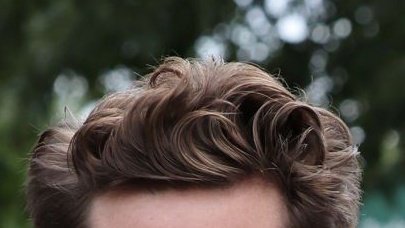
5 notes
·
View notes
Text
My hair journey:
There are exactly five years between these pictures and a lot of people ask me how my hair got from what it was to what it is.

To begin with, soon after I started the process to gain access to HRT, I realized it was going to take a while. Over two years, in fact. In the meantime I decided to start taking finasteride (Propecia), 1 mg per day. It is not marketed for hairloss in Norway, but my doctor was willing to prescribe me the 5 mg pills which are indicated for prostate problems. I cut them into quarters and was on my way. I also started using Minoxidil. The picture above left is from August 2017 and around the time I started taking it.
In the meantime, I wore wigs, waiting for a miracle. Below is from my first wig fitting. Lovely, isn't it?
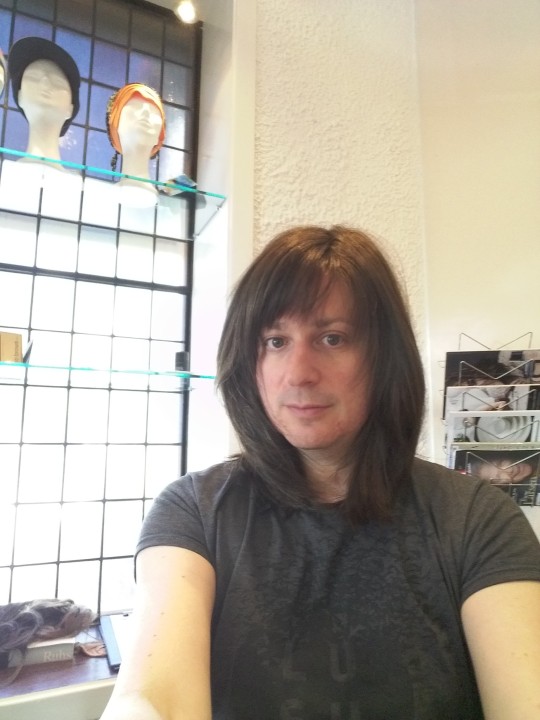
The thing with androgenic hairloss, when the hairs fall out, they are not necessarily dead. The follicle root can still be alive for years. Up to 10 years I've read somewhere, but I think 3-5 is more realistic.
It took about 2.5 years before I felt comfortable enough to lose the wigs. I had also started HRT by then. I reckon I gained back what I had lost the previous 3-4 years. My hairline was still garbage, but at least I now had enough to style around it, or wear a silly headband. The thinness on the crown was camouflaged with root color spray, which I still sometimes use. You've heard of trans on trains, how about trans on trains with pretzel? From late March, 2020.

The next big change for my hair came that summer. For my facial feminization surgery, an incision was made around the back of my head. From this, a strip of tissue was removed and the follicle grafts harvested.
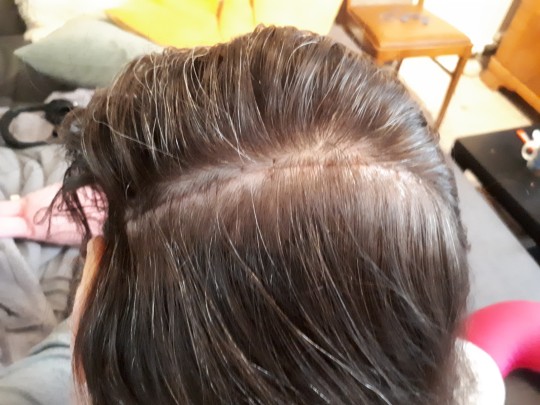
As soon as the surgery was finished, the implanting process began to rebuild my hairline.

There weren't enough grafts to give me a full hairline, but at least it got the right shape. Nothing could be done with the crown at this time.
I would end up waiting another year before deciding that a transplant to the crown was something I wanted.
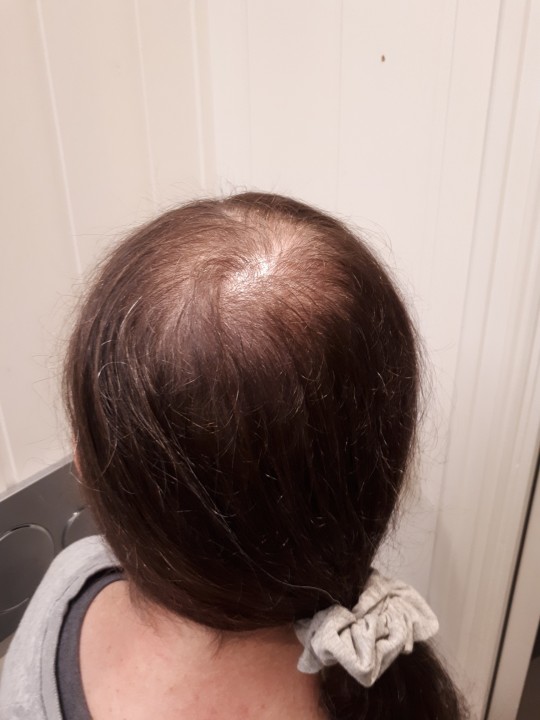
Sadly, harvesting a lot of follicles quickly involves clipping the donor area real short. Yes, by this time I was also coloring my hair.
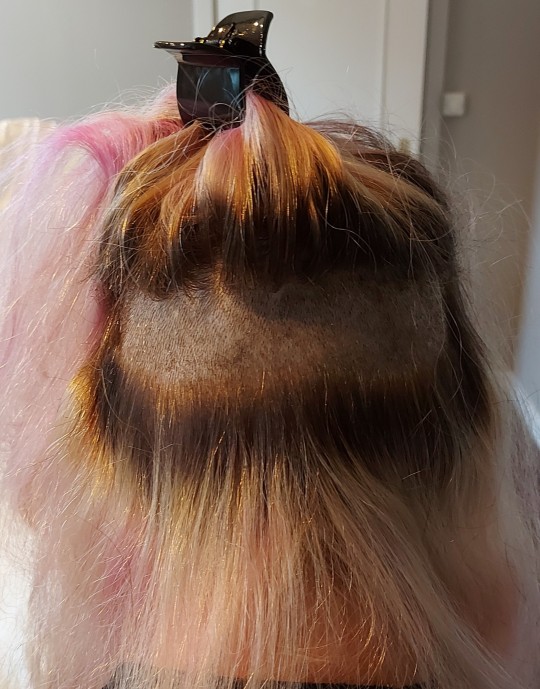
This was October 2021 and I was told I would begin to see results at 6 months, with a final result at 1 year. However, the 6 month mark did not fill me with hope.

This was distressing, but I have heard that having an illness, such as covid, and surgeries can lead to temporary hairloss. In the 6 months after my transplant I'd had covid, a flu and a surgery.
I am now at the one year mark. In the last 6 months I have had covid twice more and another surgery. Still, the result is much more encouraging.

12 notes
·
View notes
Note
I'm fine with all the other effects of T, I was just wondering if there was a way to prevent hairloss.
Hi there, I think there are a few options. I should say that I don't personally struggle with hair loss or have a family history of it so this is not my particular area of expertise. I'd check back in the notes of this post once it's been up for a bit for more information.
Before I start, to be clear- hair loss is not a guaranteed effect of T. If you have a family history of hair loss, you might experience it regardless of if you start hormones or not.
Minoxidil or Rogaine is the most common treatment for hair loss in general, as far as I'm aware- though I believe it is used to regrow lost hair, so I don't know how effective it is in preventing loss in the first place.
Finasteride or Propecia is also used pretty commonly. Its effectiveness can be hit or miss depending on your wants and needs. For example, if you don't want to take enough finasteride to significantly impact bottom growth, you might not be able to take enough to effectively prevent hair loss. If you're fine with a bit of both, though, it could be an option. This is something to discuss with a doctor because it's very specific from person to person.
Minoxidil and Finasteride are the only medications that you can be prescribed for hair loss which are approved by the USDA. Some non-medical treatments apparently work just by stimulating bloodflow to the scalp. I don't know much at all about how effective these options are, but it might be worth mentioning that apparently some researchers believe that this is all Rogaine really does. Worst case scenario, I think a scalp massage is always a good idea.
That's what I know, anyway. Hopefully this helps somewhat, though I anticipate the replies will be more insightful.
#ask box more like masc box#transmasc#HRT#mod of this blog has unruly greying hair like a geography teacher I am so sorry
3 notes
·
View notes
Text
6 Cheap Natural Hair Thickening Vitamins With Incredible Reviews And Reputations
Handmade in filled in a small pharmacy in Munich, Germany and developed by Royal Fern founder Dr. Timm Golueke together with a board certified pharmacist. Supplement Capsules provide the ideal complement to the Royal Fern Hair Serum and Royal Fern Shampoo in helping to prevent hair loss. The capsules contain both hair growth-promoting and root strengthening substances in carefully regulated dosages.
They're not necessarily the cheapest and nobody wants to spend all that money without the guarantee of longer, thicker, or healthier hair. Maybe Foligray Review is a little higher, the crown a little thinner. Though male baldness is common—two thirds of men shed at least some of their hair by the time they hit 35—the reasons for it are varied. In addition to genetics, hair loss results from certain diseases, meds, infections, radiation, toxins, and stress.
Thumbs up to Beverly Hills Hair Group, Dr. Talei, Fabien and their team. Amazing medical attention along with an incredible level of hospitality and attention. While it was once a drug to treat prostate issues, Merck released finasteride for the treatment of male pattern baldness and androgenetic alopecia in 1997. Finasteride, also called Proscar and Propecia, reduces the 5-alpha-reductase enzyme that converts testosterone into DHT, a hormone that is known for shrinking hair follicles and contributing to hair loss in men. An adaptogenic herb, ashwagandha supports our body's ability to handle stress, helping us to maintain a sense of balance, particularly during challenging times.
Vitamin B7 is a cofactor for five carboxylases that catalyze steps in fatty acid, glucose, and amino acid metabolism. Biotin also plays roles in histone modification, cell signaling, and gene regulation . Dietary protein must be broken down into free biotin, which is then stored in the small intestine and liver. An adequate intake of biotin for adults is 30 mcg/day in U.S. populations.
Saw palmetto is a type of palm tree that grows in the southeastern United States. It has long, green, pointed leaves like many types of palm trees. Saw palmetto is a weak inhibitor of the enzyme responsible for androgenic hair loss. It should not be taken by women who are pregnant or actively trying to become pregnant. If you are pregnant, breastfeeding, or taking medications, consult with your doctor before starting a supplement routine.
You can treat dullness, flaking, and early signs of aging by choosing the right foods and beverages. Zinc also has antioxidant properties and is vital to your body’s resistance to infection and for tissue repair. High doses of zinc are toxic, though, so talk to your doctor about your diet to see if you need to supplement. Citrus fruits and bell peppers are rich in this important hair-healthy vitamin. The best way to get all the nutrients you need for your hair is to eat a well-rounded, healthy diet.
#Hair Growth#Hair Growth Tips#Fast Hair Growth#Extreme Hair Growth#Hair Growth Treatment#Rice Water For Hair Growth#Hair Growth Secret#Cloves For Hair Growth#Rosemary Oil For Hair Growth#Thick Hair Growth#Average Hair Growth#Thick Hair Growth Tips#Castor Oil Hair Growth#Hair Growth Challenge#Castor Oil For Hair Growth#Growth Your Hair Naturally#Growth#Hair Growth Oil For Fast Hair Growth#Long Hair Growth#Hair Growth Hacks#Biotin Hair Growth
5 notes
·
View notes
Text
Generic Propecia (finasteride) 5mg cost

Finasteride (Proscar) is used alone or in combination with another medication (doxazosin [Cardura]) to treat benign prostatic hypertrophy (BPH, enlargement of the prostate gland). Finasteride is used to treat symptoms of BPH such as frequent and difficult urination and may reduce the chance of acute urinary retention (sudden inability to urinate).
Above content source: https://www.911globalmeds.com/info/1152-1-Finasteride-Propecia-Proscar-Medication-Patient-Information-In-English.pdf
The guaranteed Lowest Cost of Propecia / Finasteride 1mg @ $0.27 / $1.97 | 5mg @ $0.50 / $1.79 and 5 mg + 0.4 mg @ $0.58 per tablet Online.
Above Price source: https://www.genuinedrugs123.com/20-Anti-Cancer-Drugs-Generic-Finasteride-Brand-Proscar-Propecia.aspx
0 notes
Text
Propecia 1mg: The Ultimate Solution for Hair Loss
What is Propecia?
Propecia is a branded medicine on prescription that comes in daily tablets and contains the active ingredient Finasteride. Finasteride is a Type II 5-alpha reductase inhibitor and is usually the first port of call for people seeking effective treatment for hair loss. It is used primarily to treat male pattern baldness, also known as androgenetic alopecia.
How does Propecia work for hair loss?
Hair loss is a natural part of the hair’s life cycle for men and women. However, in men, a change in the way scalp cells react to testosterone can lead to thinning hair, which can eventually result in baldness.
Propecia 1 mg is used to treat common male pattern baldness, also known as androgenetic alopecia. This condition, often passed down through families, makes hair follicles shrink over time because they are sensitive to a hormone called dihydrotestosterone (DHT).
A natural body process changes testosterone, a male hormone, into a different hormone called dihydrotestosterone (DHT) using an enzyme (a type of protein) called 5-alpha reductase. Hair follicles are sensitive to DHT, and with increased exposure to the hormone, the follicles narrow.
When levels of DHT get too high, it can make hair follicles shrink. This means that every time a hair falls out naturally, the new hair grows back a little bit narrower. Eventually, the hair is so fine that it can’t break through the surface of the skin.
Propecia works by blocking this enzyme, which reduces the levels of DHT. Lower DHT levels help hair follicles to grow back to their normal size, leading to a thicker and healthier head of hair. Then hair can grow again like normal. Research shows that 4-6 months after taking
Propecia, up to 60% less DHT is present in the scalp. This works to regrow hair in 9 out of 10 men with male pattern baldness.
How effective is Propecia in treating hair loss?
Clinical studies have found Propecia to be very effective in treating male pattern hair loss. For example, in a major study over 5 years, 90% of men who took Propecia every day either kept their existing hair or saw hair regrowth. This was much higher than the 25% of men who saw these effects while taking a placebo (a pill with no active ingredient).
Additionally, over 66% of men using Propecia for 2 years observed at least 50% more visible hair, whereas only 7% of the placebo group had similar results. So, the evidence shows that Propecia enables the vast majority of men taking it to regrow hair successfully.
How long does Propecia take to work?
Like many treatments for progressive conditions, Propecia works best when started early. However, positive effects are often seen after 3-6 months of consistent daily use. It may then take 9-12 months to see the full desired response in terms of halted hair loss combined with noticeable regrowth.
Maximum Hair regrowth from Propecia may take 1-2 years before becoming evident. So, while Propecia cannot work overnight, it does reliably spur improved hair growth over a period of months for most men.
Who benefits from Propecia?
Men with diagnosed male pattern baldness (androgenetic alopecia) - those with genetic hair loss and shrinking follicles
Men in the early stages of balding who still have active, salvageable follicles
Men with moderate to extensive hair loss focused on the anterior scalp region and crown
Adults over age 18 with balding (safety/efficacy not established for teens)
Not recommended for men who are already near or completely bald in the scalp area
0 notes
Text
Effective Hair Loss Treatments You Should Know About
Losing hair can be a distressing experience for anyone. Whether you're a man or a woman, the sight of thinning hair or bald patches can affect your confidence and self-esteem. Fortunately, there are several effective hair loss treatmentsavailable that can help combat hair loss and promote regrowth. In this article, we'll explore some of the most promising options for addressing hair loss.
MINOXIDIL (ROGAINE):
Minoxidil is perhaps one of the most well-known and widely used hair loss treatments. Minoxidil, available over the counter, comes in the form of a topical solution or foam that is applied directly to the scalp. It works by increasing blood flow to the hair follicles, stimulating hair growth in areas where it has become thin. While it may not work for everyone, many people have experienced significant regrowth with regular use.
FINASTERIDE (PROPECIA):
Finasteride is an oral medication that is primarily used to treat male pattern baldness. It works by blocking the conversion of testosterone into dihydrotestosterone (DHT), a hormone that can shrink hair follicles and lead to hair loss. By reducing DHT levels in the scalp, finasteride helps to prevent further hair loss and may even promote regrowth in some individuals. However, it's important to note that finasteride is not suitable for use by women and may cause side effects in some men.
HAIR TRANSPLANT SURGERY:
For those seeking a more permanent solution to hair loss, hair transplant surgery can be an effective option. During this procedure, hair follicles are taken from areas of the scalp where hair is plentiful (often the back or sides of the head) and transplanted to balding or thinning areas. While hair transplant surgery can be expensive and may require multiple sessions to achieve desired results, it can provide natural-looking and long-lasting hair restoration for many individuals.
PLATELET-RICH PLASMA (PRP) THERAPY:
PRP therapy is a relatively new treatment for hair loss that involves injecting a concentrated solution of platelets from the patient's own blood into the scalp. These platelets contain growth factors that can stimulate hair follicles, promote healing, and encourage hair growth. While more research is needed to fully understand the effectiveness of PRP therapy for hair loss, many people have reported positive results with this treatment.
LOW-LEVEL LASER THERAPY (LLLT):
LLLT, also known as red light therapy or cold laser therapy, is a non-invasive treatment for hair loss that uses low-level laser light to stimulate hair follicles and improve scalp circulation. This can lead to increased hair growth and thicker, healthier hair over time. LLLT devices are available for home use in the form of handheld combs or helmets, as well as in professional settings such as hair clinics.
DIETARY SUPPLEMENTS:
Certainvitamins, minerals, and herbal supplements have been shown to support healthy hair growth and may help to prevent or slow down hair loss. For example, biotin, vitamin D, iron, and zinc are all essential nutrients for maintaining strong and healthy hair. Additionally, herbs such as saw palmetto and pumpkin seed extract have been studied for their potential to block DHT and promote hair growth.
LIFESTYLE CHANGES:
Making certain lifestyle changes can also have a positive impact on hair health and may help to prevent or reduce hair loss. Avoiding tight hairstyles that pull on the hair, reducing stress through relaxation techniques or exercise, and maintaining a balanced diet rich in fruits, vegetables, and lean proteins can all contribute to healthier hair growth.
It's important to remember that not all hair loss treatments will work for everyone, and results may vary from person to person. Additionally, it's always a good idea to consult with a healthcare professional before starting any new treatment regimen, especially if you have underlying health conditions or are taking medications that could interact with hair loss treatments.
Conclusion:-
While dealing with hair loss can be challenging, there are a variety of effective hair loss treatments available to help address the issue. Whether you opt for over-the-counter medications like minoxidil, more invasive procedures like hair transplant surgery, or natural remedies like dietary supplements and lifestyle changes, finding the right approach for you may take some trial and error. With patience and persistence, however, many people are able to achieve significant improvements in hair growth and regain their confidence in their appearance.
If you are experiencing sudden hair loss always make time to visit your doctor or medical professional. If you would like to prevent hair thinning, due to stress, diet or hormonal changes or even if you would just like to improve your hair’s strength, length and speed of growth, here are two great plant based options from SuperFoodLx
The Key. This is a 100% plant based option utilising the vitamin and mineral rich components from the organic seams and moringa. It also contains bamboo silica to promote strength and shine in the hair and nails as well as collagen production for improved hydration in the skin and scalp. The amino acids are also for ensuring hair strength and are also fantastic for reducing menopausal symptoms. The pre and probiotics and gut health, optimum nutrient absorption and also promotes hair growth.
Kelp & Spirulina, Hair Skin and Nails utilising the full spectrum of the highest grade vitamins and minerals for optimum hair growth. The organic kelp and spirulina are nutrient dense and rich in chlorophyll to aid detoxification and optimise scalp health. This unique blend has resulted in several amazing before and after case studies which can be seen at https://superfoodlx.com/
0 notes
Text
How Expensive Is Finasteride Proscar Propecia
Generic FINASTERIDE / Brand PROPECIA PROSCAR 1mg / 2.5mg / 5mg Tablet is used for treating loss of hairs. Early forms of male pattern loss of hair which is also known as androgenetic alopecia is treated with this medicine. Finasteride / Propecia Proscar medicine is classified as 5-alpha reductase inhibitor that works by blocking the production of body of a male hormone in the scalp that stops growth of hairs, thereby reversing the process of balding and preventing further loss of hair.
Content Source - https://www.911globalmeds.com/buy-finasteride-propecia-proscar-online
Finasteride 1 mg Tablet (Generic of PROPECIA)
200 Tablet | US$ 95 US$ 86 | Save 9 % | Buy Now
400 Tablet | US$ 183 US$ 167 | Save 3 % + 9 % | Buy Now
800 Tablet | US$ 359 US$ 327 | Save 5 % + 9 % | Buy Now
1600 Tablet | US$ 703 US$ 640 | Save 7 % + 9 % | Buy Now
Finasteride 1 mg Tablet (Brand PROPECIA, Merck)
112 Tablet | US$ 253 US$ 230 | Save 9 % | Buy Now
224 Tablet | US$ 496 US$ 452 | Save 2 % + 9 % | Buy Now
448 Tablet | US$ 982 US$ 894 | Save 3 % + 9 % | Buy Now
896 Tablet | US$ 1944 US$ 1769 | Save 4 % + 9 % | Buy Now
Finasteride 5 mg Tablet (Generic of PROSCAR)
100 Tablet | US$ 59 US$ 54 | Save 9 % | Buy Now
200 Tablet | US$ 115 US$ 105 | Save 3 % + 9 % | Buy Now
400 Tablet | US$ 226 US$ 205 | Save 5 % + 9 % | Buy Now
800 Tablet | US$ 442 US$ 402 | Save 7 % + 9 % | Buy Now
Finasteride 5 mg Tablet (Brand PROSCAR, Merck)
112 Tablet | US$ 229 US$ 209 | Save 9 % | Buy Now
224 Tablet | US$ 450 US$ 409 | Save 2 % + 9 % | Buy Now
448 Tablet | US$ 890 US$ 810 | Save 3 % + 9 % | Buy Now
896 Tablet | US$ 1762 US$ 1604 | Save 4 % + 9 % | Buy Now
0 notes
Text
Combating Male Pattern Baldness: Tips and Techniques
Male pattern baldness, medically known as androgenetic alopecia, is a common condition that affects many men world-wide. It can start as early as the teenage years and tends to progress with age. While it's largely genetic, the impact of seeing your hair thin and recede can be distressing. Although there's no complete cure for male pattern baldness, there are various strategies you can adopt to slow its progression and, in some cases, potentially regrow some hair. Below, we explore some of the most effective tips and techniques for managing this condition.
Understanding the Basics
Male pattern baldness is influenced by genetics and the hormone dihydrotestosterone (DHT). It typically follows a pattern starting from the hairline, gradually moving back to form an "M" shape, and thinning at the crown. Recognizing the signs early on can be key to managing the condition effectively.
Medical Treatments
1. Minoxidil
One of the most well-known treatments, Minoxidil (Rogaine), is a topical solution that can help slow hair loss. It’s available over the counter and works by stimulating hair growth and prolonging the growth phase of hair follicles. Consistency and patience are key, as it may take several months to notice any improvement.
2. Finasteride
Finasteride (Propecia) is a prescription oral medication that can slow hair loss by inhibiting the production of DHT, the hormone responsible for androgenetic alopecia. Studies have shown that it can not only prevent further hair loss but also promote hair regrowth in some men.
Lifestyle Changes and Natural Remedies
1. Diet and Nutrition
A well-balanced diet rich in vitamins and minerals can support hair health. Include foods high in iron, zinc, and vitamin D, as deficiencies in these nutrients have been linked to hair loss.
2. Scalp Massage
Regular scalp massages may help to stimulate blood flow to the scalp and encourage hair growth. Using essential oils, such as peppermint or rosemary oil, in conjunction with massages might amplify the benefits, though research on their efficacy is limited.
3. Reduce Stress
Chronic stress can exacerbate hair loss. Adopt stress-reduction techniques such as meditation, yoga, or regular exercise to help manage stress levels effectively.
Surgical Options
For some men, hair transplantation may be considered. This procedure involves moving hair follicles from a part of the body (usually the back of the head) to balding areas. It can improve the appearance significantly, but it's important to have realistic expectations and understand the potential risks and costs involved.
Hair Styling Tips
While changing the way you style your hair won't stop hair loss, it can make your hair appear fuller and cover up thinning areas. Consider working with a stylist who understands male pattern baldness to find a cut that suits you best. Additionally, using volumizing shampoos and avoiding heavy styling products can help your hair look thicker.
When to See a Doctor
If you're concerned about hair loss, it's a good idea to consult a doctor or dermatologist. They can confirm whether you're experiencing male pattern baldness or if your hair loss is due to another condition. Additionally, they can provide guidance on the most appropriate treatment options for your situation.
Final Thoughts
While battling male pattern baldness can feel like an uphill struggle, it's important to remember that you're not alone. Thanks to advances in treatment and a greater understanding of the condition, there are now more options than ever to manage hair loss. Whether you opt for medical treatments, lifestyle changes, or surgical options, it's possible to positively impact your hair's appearance and how you feel about it. Regardless of the path you choose, focusing on overall wellness can also play a crucial role in how you manage male pattern baldness.
0 notes
Text
Vancouver Hair Loss Guide: Understanding & Solutions
Are you a Vancouver resident experiencing hair loss? You're not alone. Hair loss affects people of all ages and genders, and it can have a significant impact on self-esteem and confidence. In this guide, we'll explore the causes of hair loss, treatment options available in Vancouver, and tips for managing and coping with hair restoration vancouver bc.

Understanding Hair Loss
Hair loss, also known as alopecia, can occur for various reasons, including genetics, hormonal changes, medical conditions, and lifestyle factors. One of the most common types of hair loss is androgenetic alopecia, also known as male or female pattern baldness, which is hereditary and typically progresses with age, hair replacement toronto.
Other causes of hair loss include:
Stress: High levels of stress can lead to a condition called telogen effluvium, where hair prematurely enters the resting phase of the hair growth cycle, causing increased shedding.
Nutritional Deficiencies: Poor diet lacking essential nutrients like iron, protein, and vitamins can contribute to hair loss.
Medical Conditions: Certain medical conditions such as thyroid disorders, autoimmune diseases, and scalp infections can cause hair loss.
Medications: Some medications, including those used for cancer, arthritis, depression, and high blood pressure, can cause hair loss as a side effect.
Treatment Options in Vancouver
If you're experiencing hair loss in Vancouver, there are several treatment options available:
Topical Treatments: Over-the-counter and prescription topical treatments, such as minoxidil (Rogaine), can help stimulate hair growth and slow down hair loss.
Prescription Medications: Finasteride (Propecia) is an oral medication approved for the treatment of male pattern baldness. It works by inhibiting the conversion of testosterone into dihydrotestosterone (DHT), a hormone that contributes to hair loss.
Platelet-Rich Plasma (PRP) Therapy: PRP therapy involves injecting a concentrated form of the patient's own blood plasma into the scalp to stimulate hair growth.
Hair Transplant Surgery: Hair transplant surgery involves removing hair follicles from areas of the scalp with healthy hair growth and transplanting them into balding or thinning areas.
Laser Therapy: Low-level laser therapy (LLLT) devices can be used at home or in clinics to stimulate hair follicles and promote hair growth.
Managing and Coping with Hair Loss
Dealing with hair loss can be emotionally challenging, but there are ways to manage and cope with it:
Seek Support: Don't hesitate to reach out to friends, family, or support groups for emotional support and understanding.
Focus on Self-Care: Engage in activities that make you feel good about yourself, such as exercise, hobbies, and self-care practices.
Consider Counseling: Speaking with a therapist or counselor can help you process your feelings about hair loss and develop coping strategies.
Experiment with Hairstyles: Experiment with different hairstyles, cuts, and hair accessories to find a look that makes you feel confident and comfortable.
Explore Alternative Therapies: Consider trying alternative therapies such as acupuncture, herbal supplements, or aromatherapy to support hair health.
In conclusion, hair loss is a common issue that affects many Vancouver residents, but it doesn't have to define you. By understanding the causes of hair loss, exploring treatment options available in Vancouver, and adopting coping strategies, you can navigate this journey with confidence and resilience. Remember, you are not alone, and there is support and help available to you.
#micropigmentation training#hair replacement vancouver#vancouver hair loss#hair loss vancouver#vancouver hair replacement#scalp micropigmentation training vancouver
0 notes
Text

Hair loss is a common concern for many people, affecting both men and women of all ages. While it's normal to lose some hair every day, excessive hair loss can be distressing and impact self-esteem. Understanding the causes, available treatments, and prevention options is essential for managing this condition effectively.
Causes of Hair Loss:
Genetics (Androgenetic Alopecia): Hereditary factors play a significant role in hair loss, with patterns differing between men and women.
Hormonal Changes: Hormonal imbalances due to pregnancy, childbirth, menopause, or thyroid problems can lead to temporary or permanent hair loss.
Medical Conditions: Certain medical conditions like alopecia areata, scalp infections, and autoimmune diseases can cause hair loss.
Medications: Some medications, including chemotherapy drugs, blood thinners, and antidepressants, may cause hair loss as a side effect.
Stress: Physical or emotional stress can disrupt the hair growth cycle, leading to temporary hair loss known as telogen effluvium.
Treatment Options:
Medications:
Minoxidil (Rogaine): Available over-the-counter, minoxidil is applied directly to the scalp to stimulate hair growth.
Finasteride (Propecia): This prescription medication is specifically for men and works by blocking the hormone responsible for hair loss.
Hair Transplant Surgery: In this procedure, hair follicles from a donor site are transplanted to the balding area.
Platelet-Rich Plasma (PRP) Therapy: PRP involves injecting the patient's own platelet-rich plasma into the scalp to promote hair growth.
Low-Level Laser Therapy (LLLT): LLLT devices emit red light to stimulate hair follicles and improve hair growth.
Scalp Micropigmentation (SMP): SMP involves tattooing the scalp to create the illusion of thicker hair.
Prevention Strategies:
Healthy Lifestyle: Eating a balanced diet rich in vitamins and minerals, staying hydrated, and exercising regularly can promote overall health, including healthy hair growth.
Gentle Hair Care: Avoid harsh treatments like frequent dyeing, perming, or using hot styling tools, as these can damage the hair follicles.
Stress Management: Practicing stress-reducing techniques such as meditation, yoga, or deep breathing exercises can help prevent stress-related hair loss.
Regular Scalp Massage: Massaging the scalp stimulates blood flow to the hair follicles, promoting hair growth and overall scalp health.
Avoid Tight Hairstyles: Pulling hair tightly into ponytails, braids, or buns can cause traction alopecia, a form of hair loss caused by excessive tension on the hair shafts.
Conclusion: Hair loss can have various causes, ranging from genetics to medical conditions and lifestyle factors. Fortunately, numerous treatment options are available, from medications and surgeries to non-invasive therapies. Additionally, adopting preventive measures such as a healthy lifestyle and proper hair care can help maintain hair health and minimize the risk of excessive hair loss. Consulting a dermatologist or trichologist for personalized advice and treatment recommendations is crucial for effectively managing hair loss.
0 notes
Video
youtube
How to use FINASTERIDE (propecia) for BPH / hair loss including doses, s...
0 notes
Text
Combatting Hair Loss: Effective Treatment Options for Men
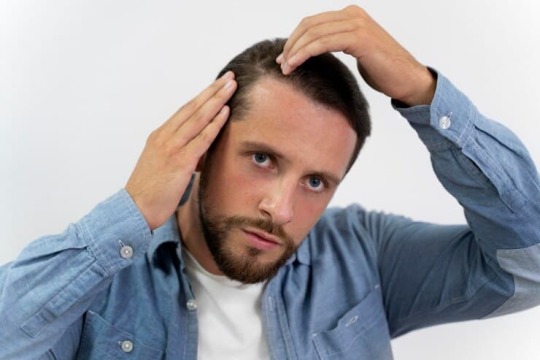
Hair loss, medically known as alopecia, is a common concern among men, affecting millions worldwide. While it can be distressing, the good news is that several effective treatment options exist to combat hair loss and promote regrowth. From lifestyle changes to medical interventions, let's explore some of the most effective strategies available.
Understanding Hair Loss
Before delving into treatment options, it's essential to understand the underlying causes of hair loss. While genetics play a significant role in male pattern baldness, other factors such as hormonal imbalances, stress, poor nutrition, and certain medical conditions can also contribute to hair thinning and balding.
Lifestyle ModificationsHealthy Diet:
A balanced diet rich in vitamins, minerals, and proteins is crucial for maintaining healthy hair. Foods high in iron, zinc, vitamin D, and omega-3 fatty acids can support hair growth and minimize shedding. Stress Management: Chronic stress can disrupt hormonal balance and contribute to hair loss. Engaging in relaxation techniques such as meditation, yoga, or regular exercise can help alleviate stress and promote hair health. Scalp Care: Keeping the scalp clean and well-nourished is essential for healthy hair growth. Regular washing with a gentle shampoo and scalp massages to improve circulation can stimulate follicles and promote thicker hair.
Over-the-Counter TreatmentsMinoxidil (Rogaine):
Minoxidil is a topical solution applied directly to the scalp, which has been FDA-approved for treating male pattern baldness. It works by prolonging the hair growth cycle and increasing follicle size, leading to thicker hair regrowth. However, consistent and long-term use is necessary to maintain results. Nutritional Supplements: Supplements containing biotin, vitamins (such as Biotin and Vitamin D), and minerals like iron and zinc are often marketed for promoting hair growth. While research on their effectiveness is mixed, some men may benefit from supplementing their diet with these nutrients, especially if deficiencies are present.
Prescription MedicationsFinasteride (Propecia):
Finasteride is an oral medication that works by inhibiting the conversion of testosterone to dihydrotestosterone (DHT), a hormone implicated in male pattern baldness. It's shown to be effective in slowing down hair loss and even promoting regrowth in some men. However, it's essential to discuss potential side effects, such as decreased libido and erectile dysfunction, with a healthcare provider before starting treatment. Low-Level Laser Therapy (LLLT): LLLT devices, such as laser combs or helmets, emit low-power lasers or light-emitting diodes that stimulate hair follicles' activity. While the exact mechanism is not fully understood, some studies suggest that LLLT can improve hair density and thickness, making it a non-invasive option for hair loss treatment for men.
Hair Transplant Surgery
For men experiencing advanced hair loss or seeking more permanent solutions, hair transplant surgery offers a viable option. During the procedure, hair follicles are harvested from areas of the scalp resistant to balding (donor sites) and transplanted into bald or thinning areas. Techniques such as follicular unit transplantation (FUT) and follicular unit extraction (FUE) have advanced significantly, providing natural-looking results with minimal scarring.
Conclusion
Hair loss can have a significant impact on men's self-esteem and quality of life, but effective treatment options are available to address this common concern. Lifestyle modifications, including a healthy diet, stress management, and scalp care, form the foundation of hair loss prevention and maintenance. Over-the-counter treatments like minoxidil and nutritional supplements may help promote hair growth, while prescription medications such as finasteride offer additional options for combating male pattern baldness. For those seeking more permanent solutions, hair transplant surgery provides a viable option with natural-looking results. Consulting with a healthcare provider or dermatologist can help determine the most suitable treatment plan based on individual needs and preferences. Remember, addressing hair loss early and proactively can yield the best outcomes in preserving and regaining a full head of hair.
0 notes
Text
Ideas You Can Use When Facing Hair LossThere are a lot of people that have lost hair that want to learn how they can go about getting it back. There are ways to go about getting some hair back but you need to educate yourself, as much as possible, in order to hope for success. This article is geared towards helping you learn what you can to help you better your life.<br/><br/>When it comes to hair loss it is important to know the impact that genetics has on it. Hair loss can be hereditary. As such if someone in your family true suffered from hair loss, it is more likely you will too. Be informed and you'll have a better chance against whatever happens.<br/><br/>Your diet should include a fair amount of protein in order to slow down hair loss. Many foods, such as legumes, meats and eggs are high in protein. Your hair will take the protein it needs from this in the form of keratin. If your hair consistently receives keratin, it will increase in strength and resiliency, reducing your rate of hair loss.<br/><br/>Vitamin E is a wonderful addition to your arsenal to combat the signs of hair loss. You can use this vitamin in oil form to moisturize your scalp and strengthen your hair. Additionally, you can take this vitamin in pill form to reduce brittle hair that is prone to falling out.<br/><br/>It is crucial that you have enough monounsaturated fats and polyunsaturated fats in your diet in order to prevent hair loss. Unlike unhealthy fats, these provide your body and scalp with the nutrition you need in order for hair to stay healthy and stay in place. <a href="https://www.aslitarcanclinic.com/language/en/average-price-of-hair-transplant-turkey/">hair transplant istanbul price</a> in these fats include peanut butter, vegetable oil, and avocados.<br/><br/>When you take a shower in the morning, make sure that you wash all the shampoo out of your hair. Leaving traces of shampoo on your scalp during the day can make your hair very brittle. Wash your hair with water for an extra ten seconds to reduce all traces of shampoo.<br/><br/>The most essential foods that you can put in your body for your hair are fruits. Fruits contain a plethora of beneficial nutrients and complement any meal during the day or night. Eat fruit to obtain a high dose of vitamin C, which helps with collagen formation for your hair.<br/><br/>There are two FDA-approved medications, Minoxidil and Finasteride, for treating inherited hair loss (androgenic alopecia).You can get Minoxidil (Rogaine) without a prescription. It is to sprayed or rubbed into the scalp twice daily. A prescription is needed for Finasteride (Propecia). Finasteride is not approved for women. It comes in pills to be taken once a day.<br/><br/>Hair loss and thinning can happen to women as well as men. This type of balding occurs with aging and can start in the 20's and 30's. Female hair loss can be successfully treated if it is due to common disorders such as thyroid disease and anemia, among others.<br/><br/>Relaxation techniques can help dilate your blood vessels and increase circulation to your hair follicles, decreasing the amount of hair you lose. Stress constricts your blood flow, in the scalp as well as elsewhere in the body, which will lead to hair loss. Meditation and massages can increase blood flow to your scalp, and possibly stimulate hair growth.<br/><br/>Having toxins in your body can help speed up the hair loss process, so you should aim to drink at least 8 glasses of water daily to help strengthen your hair. Drinking this amount of water helps to purge your body of the toxins that can damage hair follicles. Once these toxins are gone, your hair can grow strong.<br/><br/>Many people still think it's a myth that hats and rubber bands can cause hair loss in women, but in fact, it's partially true. While hats and ponytails won't actually cause balding, repeated friction and tightly pulled hair can cause localized hair loss and breakage at the hairline. Use coated hair bands and don't pull hair too tightly to keep this to a minimum.<br/><br/>Hopefully, with the information you learned about hair loss and how to go about getting it back you should start to feel more positive. When it comes to hair loss, remember that new information is always coming out so make sure that you continuously seek new sources of knowledge that can benefit you. If you keep on educating yourself and applying all that you learn, then you should see results before you know it.
0 notes